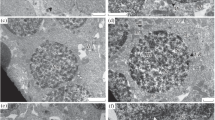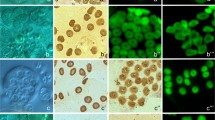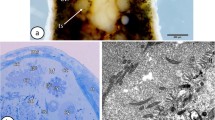Summary
Nurse cells develop from diploid cells in the testis. Each cell undergoes a reduction division which leaves the nucleus with half the volume of a normal diploid cell. They send out pseudopodia which form desmosomelike junctions with developing spermatids. The nurse cells detach from the testicular wall, their nuclei degenerate and secretion droplets form in the cytoplasm. The pseudopodia are drawn in as the cytoplasmic secretions swell and the nurse cell becomes spherical. The eupyrene sperm become grouped unilaterally and at this stage are attached to the nurse cell by only the tips of their acrosomes. At maturity the nurse cells with their clumps of attached eupyrene sperm (spermatozeugmata) are released from the testis via ducts into the seminal vesicles, where they are stored prior to copulation. Nurse cells serve similar functions to those of apyrene sperm which are common among the Molluscs. We believe that the nurse cell and apyrene sperm are homologous.
Similar content being viewed by others
References
Ankel, W.E.: Über das Vorkommen und die Bedeutung zwittriger Geschlechtzellen bei Prosobranchiern. Biol. Zbl. 50, 513–531 (1930)
Bloom, W., Fawcett, D.W.: A text book of histology, 9th ed. Philadelphia-London-Toronto: Saunders 1968
Buckland-Nicks, J.A.: The fine structure of the spermatozoan of Littorina (Gastropoda: Prosobranchia), with special reference to sperm motility. Z. Zellforsch. 144, 111–129 (1973)
Buckland-Nicks, J.A., Chia, F.S.: Spermatogenesis of a marine snail, Littorina sitkana. Cell Tiss. Res. 170, 455–475 (1976)
Bulnheim, H.-P.: Atypical spermatozoa formation in Epitonium tinctum. A contribution to the problem of spermatozooic dimorphism of the Prosobranchia. Helgoländer Wiss. Meerensunters. 18, 232–253 (1968)
Fretter, V., Graham, A.: British prosobranch molluscs, their functional anatomy and ecology. London: The Ray Society 1962
Goldschmidt, R.: The function of the apyrene spermatozoan. Science 44, 544–546 (1916)
Koshman, R.W., Serra, J.A.: Spireme karyodieresis, a new type of somatic reductional division. Canad. J. Genet. Cytol. 9, 31–37 (1967)
Munn, E.A., Barnes, H.: The fine structure of the spermatozoa of some cirripedes. J. exp. Mar. Biol. Ecol. 4, 261–286 (1970)
Reinke, E.E.: A preliminary account of the development of apyrene spermatozoa in Strombus and of the nurse cells in Littorina. Biol. Bull. 22, 319–327 (1912)
Serra, J.A., Koshman, R.W.: Nuclear changes of treptional nature in the differentiation of sperm nurse cells in snails. Canad. J. Genet. Cytol. 9, 23–30 (1967)
Author information
Authors and Affiliations
Rights and permissions
About this article
Cite this article
Buckland-Nicks, J.A., Chia, FS. On the nurse cell and the spermatozeugma in Littorina sitkana . Cell Tissue Res. 179, 347–356 (1977). https://doi.org/10.1007/BF00221105
Accepted:
Issue Date:
DOI: https://doi.org/10.1007/BF00221105




